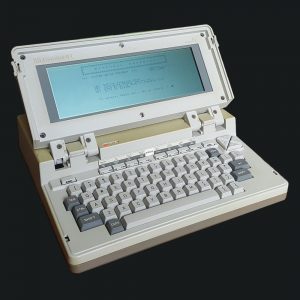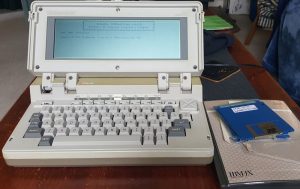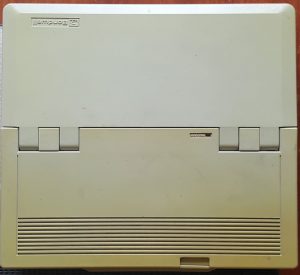
Bondwell Model 2
Posted by musovern on Apr 10th, 2018 in Bondwell, Vintage Computers | 0 comments
This machine was produced by the Bondwell Holding Company, LLC, of Hong Kong, and came out in 1985. It arrived an interesting juncture of the death of CP/M and the birth of laptop computers. While there are earlier laptops and even earlier CP/M laptops, the Bondwell Model 2 came late enough that there was good enough LCD resolution (640×200) to support an 80×25 line display; CMOS chips were advanced enough to allow long battery life (up to eight hours), and 3.5 inch floppies were already commonplace. The only technology lacking from today’s perspective is that this machine used two heavy 6V sealed lead acid batteries for its power source.
A low power Z80 running at 4 MHz (despite the fact that some docs say 2 MHz)
64 KB of DRAM
a 4 KB EPROM containing the boot code (2 KB) and character map (2 KB)
16 KB of SRAM for the frame buffer (bitmapped 640×200 = 128000 bits = 16000 bytes)
an MSM6255 LCD controller chip driving the Citizen 640×200 LCD panel (no backlight)
an 82C51 serial interface controller chip
an 82C53 programmable interval timer chip
an 82C55 PIO chip for controlling the keyboard, memory banking, and floppy drive controls
a discrete chip implementation for the parallel port
a TMS2797 FDC controller, software compatible with the FD179x family of FDCs
a TEAC FD-35 floppy disk drive (SS/DD, 360 KB capacity)
two 6V sealed lead acid batteries, wired in series a switching regulator to produce regulated +12V, +5V, and -13V from the ~12V lead acid battery
Beneath the case is a single slot where an expansion cartridge can be plugged in. One such cartridge is the RAMCARD. This contains up to 512 KB of DRAM and a 16 KB or 32 KB EPROM. This extra RAM is configured as a RAM disk, and the EPROM contains code that configures it.
The rear of the machine has a fold-down door exposing three I/O connectors. One is for the serial port, one for the parallel port, and one for an external floppy disk drive. All use non-standard pin-outs to reduce the connectors’ sizes.
Note that the machine has more (with the RAMCARD, a lot more) than 64 KB of things to address. Three of the 8255 PIO chip pins are used to control memory banking. Memory is split with the upper 32 KB being fixed to always map to 32 KB of the 64 KB on the motherboard. The lower 32 KB of the address space can be mapped to the other 32 KB of motherboard DRAM, or the boot ROM, or the video RAM, or the expansion slot. While the other six bank enables appear on the expansion slot interface, the RAMCARD uses one 32 KB aperture to write to a control register in the RAMCARD to provide more bank bits. Without that second level banking, the RAMCARD would have been limited to 180 KB or so (six banks of 32 KB).
As was mentioned, the graphics are bitmapped at 640×200. The text is drawn in software by splatting the pixels for the character so the appropriate place in the display RAM. As a result, text output is quite slow. Typing a document from the RAM disk on a 4 MHz CPU should tear, but on the BW2, it leaves just about enough time to read the document as it scrolls past.
Passed all tests


Leave a Reply